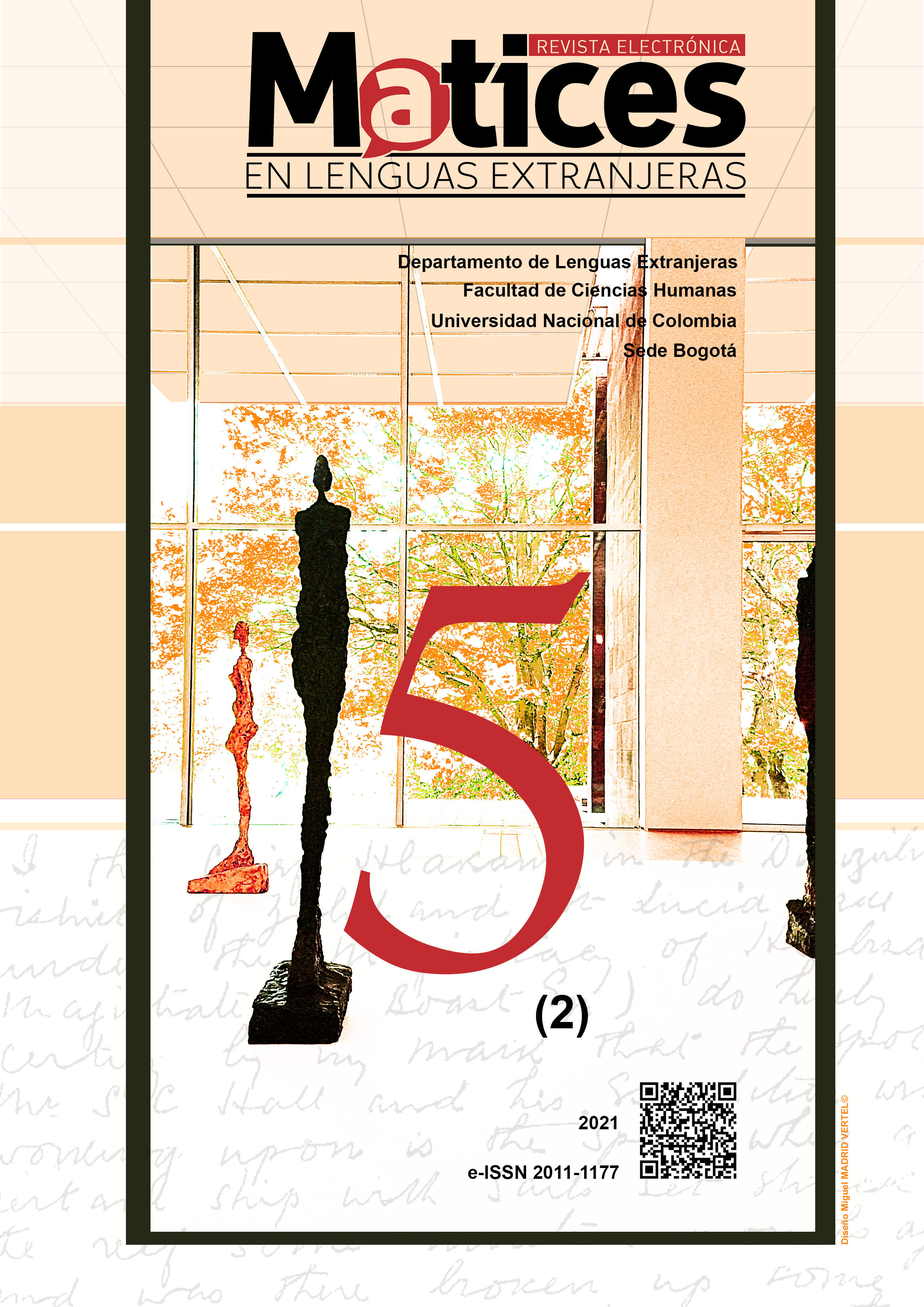An Analysis of Contextual Characteristics for the Successful Design and Implementation of a Blended English Learning Program in a Higher Education Institution: A Possibility to Innovate
El análisis del contexto para el diseño e implementación exitoso de un programa de inglés en modalidad semipresencial en una institución de educación superior, una posibilidad de innovación
DOI:
https://doi.org/10.15446/male.v15n2.103282Palabras clave:
blended learning modality, needs analysis study, pedagogical innovation, qualitative and quantitative analysis of information (en)análisis cualitativo y cuantitativo, análisis de necesidades, innovación pedagógica, modalidad semipresencial (es)
Descargas
Archivos adicionales
Innovations are usually associated with new technologies and applications. When it comes to teaching, the term pedagogical innovation is to introduce something new to improve learning and teaching conditions. This investigation seeks to analyze the characteristics of context to design and implement a pedagogical innovation that materializes into an English program in a blended learning modality. This is a needs analysis study that includes qualitative and quantitative types of information. The participants in the study are students, teachers, and administrative staff. This investigation employs questionnaires, in-depth interviews, and a focus group. The study concludes that to have a sustainable pedagogical innovation, the content should be based on the participants’ academic areas, and the pedagogical innovation should foster the development of critical thinking, academic skills, autonomy, and collaboration.
Usualmente la innovación se asocia a avances tecnológicos, pero cuando se trata de introducir algo nuevo para mejorar los procesos de enseñanza y aprendizaje, el término que se emplea es innovación pedagógica. Esta investigación busca identificar las características del contexto para diseñar e implementar una innovación pedagógica, que para este caso se trata del diseño de un programa de inglés en modalidad semipresencial (blended learning). Este estudio es un análisis de necesidades que emplea análisis cualitativo y cuantitativo de información. Los participantes en este estudio son estudiantes, profesores y personal administrativo y los instrumentos de recolección de información son cuestionarios, entrevistas a profundidad y un grupo focal. El estudio concluye que para tener una innovación pedagógica sostenible el contenido se debe alinear con las áreas de estudio de los participantes, se debe fomentar el desarrollo del pensamiento crítico, de las habilidades académicas, la autonomía y la colaboración.
Referencias
Akyel, A. S., & Ozek, Y. (2010). A language needs analysis research at an English medium university in Turkey. Procedia - Social and Behavioral Sciences, 2(2), 969–975. https://doi.org/10.1016/j.sbspro.2010.03.136
Aydemir, M., Kurşun, E., & Karaman, S. (2016). Question-Answer Activities in Synchronous Virtual Classrooms in Terms of Interest and Usefulness. Open Praxis 8(1), 9–19. DOI: https://doi.org/10.5944/openpraxis.8.1.226
Béchard, J.-P. (2000). Apprendre à enseigner au supérieur : l’exemple des innovateurs pédagogiques. Cahier de Recherche OIPG No 2000-001, 14.
Boelens, R., De Wever, B., & Voet, M. (2017). Four key challenges to the design of blended learning: A systematic literature review. Educational Research Review, 22, 1–18. https://doi.org/10.1016/j.edurev.2017.06.001
Chafiq, N., Benabid, A., Bergadi, M., Touri, B., Talbi, M., & Lima, L. (2014). Advantages and Limits of the Implementation of Blended Learning for Development of Language Skills in Scientific Students. Procedia - Social and Behavioral Sciences, 116, 1546–1550. https://doi.org/10.1016/j.sbspro.2014.01.432
Chapelle, C. (2014). Afterword: Technology-mediated TBLT and the evolving role of the innovator. In M. Gonzalez-Lloret & L. Ortega (Eds.), Technology-mediated TBLT: Researching technology and tasks. Philadelphia: John Benjamins Pub. Co.
Chostelidou, D. (2010). A needs analysis approach to ESP syllabus design in Greek tertiary education: A descriptive account of students’ needs. Procedia - Social and Behavioral Sciences, 2(2), 4507–4512. https://doi.org/10.1016/j.sbspro.2010.03.721
Creswell, J. W. (2007). Qualitative enquiry & research design, choosing among five approaches. Book (Vol. 2nd ed). https://doi.org/10.1016/j.aenj.2008.02.005
Creswell, J. W., & Miller, D. L. (2000). Determining Validity in Qualitatife Inquiry. College of Education, The Ohio State University, 39(3), 7. https://doi.org/10.1207/s15430421tip3903_2
Creswell, J. W., & Plano Clark, V. L. (2011). Designing and conducting mixed methods research. SAGE Publications.
DANE. (2021). Encuesta Nacional de Calidad de Vida (ECV) 2019-2020, 1–16. Retrieved from https://www.dane.gov.co/index.php/estadisticas-por-tema/salud/calidad-de-vida-ecv/encuesta-nacional-de-calidad-de-vida-ecv-2020
Garcia-Ponce, E. E. (2020). Needs analysis to enhance english language proficiencat a mexican university. Profile: Issues in Teachers’ Professional Development, 22(2), 145–162. https://doi.org/10.15446/profile.v22n2.82247
García Aretio, L. (2018). Blended learning y la convergencia entre la educación presencial y a distancia. RIED. Revista Iberoamericana de Educación a Distancia, 21(1), 9. https://doi.org/10.5944/ried.21.1.19683
Garrison, D. R., & Kanuka, H. (2004). Blended learning: Uncovering its transformative potential in higher education. Internet and Higher Education, 7(2), 95–105. https://doi.org/10.1016/j.iheduc.2004.02.001
Ginns, P., & Ellis, R. (2007). Quality in blended learning: Exploring the relationships between on-line and face-to-face teaching and learning. Internet and Higher Education, 10(1), 53–64. https://doi.org/10.1016/j.iheduc.2006.10.003
González-Lloret, M. (2014). The need for needs analysis in technology-mediated TBLT. In DOI: https://doi.org/10.1075/tblt.6
M. Gonzalez-Lloret & L. Ortega (Eds.), Technology-mediated TBLT: Researching technology and tasks (pp. 23–50). Amsterdam/Philadelphia: John Benjamins Pub. Co. https://doi.org/10.1075/tblt.6.02gon
González-Lloret, M. (2016). How to conduct a needs analysis of tasks and technologies. In A practical guide to integrating technology into task-basedA practical guide to integrating technology into task-based (pp. 17–33). Washington, D.C.: Georgetown University Press.
Hampel, R., & Hauck, M. (2004). Towards an effective use of audio conferencing in distance language courses. Language Learning & Technology, 8(1), 66–82. Retrieved from https://www.lltjournal.org/item/10125-25230/
Hancock, S., & Wong, T. (2012). Blended Learning - ETEC 510. Retrieved October 18, 2018, from https://wiki.ubc.ca/MET:Blended_Learning
Hosseini, S. (2015). Computer-Mediated Communication : Pedagogical and language leraning implications. International Journal on New Trends in Education & Their Implications (IJONTE), 6(1), 163–176.
Jasso-Aguilar, R. (1999). Sources, Methods and Triangulation in Needs Analysis: A Critical Perspective in a Case Study of Waikiki Hotel Maids. English for Specific Purposes, 18(1), 27–46. https://doi.org/10.1016/S0889-4906(97)00048-3
Kalyaniwala, C., & Ciekanski, M. (2021). Autonomy CALLing : A systematic review of 22 years of publications in learner autonomy and CALL. Language Learning & Teachnology, 25(3), 106–131. Retrieved from https://www.lltjournal.org/item/10125-73452/
Kaur, M. (2013). Blended Learning - Its Challenges and Future. Procedia - Social and Behavioral Sciences, 93, 612–617. https://doi.org/10.1016/j.sbspro.2013.09.248
Kitchen, M., & Gray, S. (2013). Meeting the needs of English language learners in Aotearoa New Zealand schools. Innovation in Language Learning and Teaching, 7(2), 93–106. https://doi.org/10.1080/17501229.2012.699529
Lambert, C. (2010). A task-based needs analysis: Putting principles into practice. Language Teaching Research, 14(1), 99–112. https://doi.org/10.1177/1362168809346520
Lin, H. (2014). Establishing an empirical link between computer-mediated communication (CMC) and SLA: A meta-analysis of the research. Language Learning and Technology, 18(3), 120–147. Retrieved from https://scholarspace.manoa.hawaii.edu/server/api/core/bitstreams/fc0d1c62-ab5a-4a12-87c5-44f342a7f34f/content
Ministerio de Educación Nacional. (2022). Consulta de programas académicos. Retrieved September 22, 2021, from https://hecaa.mineducacion.gov.co/consultaspublicas/programas
MinTic. (2021). Estadísticas internet móvil en Colombia. Retrieved October 21, 2021, from https://colombiatic.mintic.gov.co/679/w3-propertyvalue-47272.html
Moore, J. L., Dickson-Deane, C., & Galyen, K. (2011). E-Learning, online learning, and distance learning environments: Are they the same? Internet and Higher Education, 14(2), 129–135. https://doi.org/10.1016/j.iheduc.2010.10.001
Picciano, A. G. (2009). Blending with purpose: The multimodal model. Journal of Asynchronous Learning Network, 13(1), 7–18. https://doi.org/10.1093/elt/ccq043
Pineda Hoyos, J. E., & Tamayo Cano, L. H. (2016). E-moderating and E-tivities: The Implementation of a Workshop to Develop Online Teaching Skills in In-service Teachers. PROFILE Issues in Teachers’ Professional Development, 18(1), 97–114. https://doi.org/10.15446/profile.v18n1.44269
Ruiz-Bolivar, C., & Ríos-Cabrera, P. (2020). La innovación educativa en América Latina: lineamientos para la formulación de políticas públicas. Innovaciones Educativas, 22(32), 199–212. https://doi.org/10.22458/ie.v22i32.2828
Russell, V., & Murphy-Judy, K. A. (2020). Teaching language online : a guide for designing, developing, and delivering online, blended, and flipped language courses. Retrieved from https://www.taylorfrancis.com/books/9780429426483 DOI: https://doi.org/10.4324/9780429426483
Sabah, A., & Mohammed, E. (2018). Needs Analysis in English for Academic Purposes: The Case of Teaching Assistants at the University of Khartoum Análisis de necesidades para inglés con propósitos académicos : el caso de los asistentes de docencia. How, 25(2), 49–68. http://www.scielo.org.co/pdf/how/v25n2/0120-5927-how-25-02-00049.pdf DOI: https://doi.org/10.19183/how.25.2.409
Salmon, G. (2011). E-moderating The key to online teaching and learning. London: Routledge.
Salmon, G. (2016). The realm of learning innovation: A map for Emanators. Br J Educ Technol British Journal of Educational Technology, 47(5), 829–842. DOI: https://doi.org/10.1111/bjet.12487
Sauro, S., & Zourou, K. (2019). What are the digital wilds? Language Learning and Technology, 23(1), 1–7. https://www.lltjournal.org/item/895/
Singh, H. (2003). Building Effective Blended Learning Programs. Educational Technology, 43(6), 51–54. https://asianvu.com/digital-library/elearning/blended-learning-by_Singh.pdf
Universidad de Antioquia. (2021). Oferta Programas de Pregrado. Retrieved September 19, 2021, from https://www.udea.edu.co/wps/portal/udea/web/inicio/estudiar-udea/quieroestudiar-
¿udea/pregrado/oferta-medellin
Walder, A. M. (2014). The concept of pedagogical innovation in higher education. Education Journal, 3(3), 195–202. https://sciencepublishinggroup.com/article/10.11648/j.edu.20140303.22
Woodall, D. (2010). Blended Learning Strategies Selecting the Best Instructional Method. SkillSoft, (August). Retrieved from http://classtap.pbworks.com/f/SkillSoft+-+Blended+Elearning.pdf
Cómo citar
APA
ACM
ACS
ABNT
Chicago
Harvard
IEEE
MLA
Turabian
Vancouver
Descargar cita
Licencia
Todo el contenido de esta revista, excepto dónde está identificado, está bajo una Licencia Creative Commons Atribución-NoComercial-CompartirIgual 4.0 Internacional























